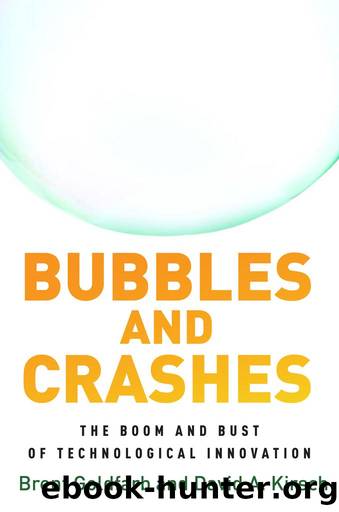Bubbles and Crashes: The Boom and Bust of Technological Innovation by Brent Goldfarb & David A. Kirsch

Author:Brent Goldfarb & David A. Kirsch [Goldfarb, Brent & Kirsch, David A.]
Language: eng
Format: epub
Tags: Business & Economics, Economic Conditions, Economic History, Economics, General, Technology & Engineering, Social Aspects
ISBN: 9780804793834
Google: 52UMtAEACAAJ
Publisher: Stanford University Press
Published: 2019-02-14T16:00:00+00:00
Transistor: A Broad Bubble with a New Set of Novices
With a total factor score of 7 out of 8 in our model, the transistor is a prime candidate for a bubble. Its first mention in the bowels of the New York Times in December 1947 suggested that the new technology might be used to make âhearing aids for the deaf.ââµâ° Transistors have two capabilities: they can amplify signals, and they can turn them on and off. It is this second capability that sits at the heart of computers, whereas the first is the foundation of the early hearing aids. That is, the transistorâthe ur-general-purpose technology that powered the digital ageâwas first recognized primarily as an analog device.
The market for products that used transistors had characteristics of uncertainty that amplified narratives. There was considerable competitive uncertainty. With the exception of IBM, incumbent vacuum-tube firms were not able to make the transition to electronics; accordingly, new entrants dominated the industry. The early market was driven by defense applications, and by the mid-1950s electronic hearing aids appeared on the consumer market. But hearing aids have limited resonance with the public. Nevertheless, the transistor had a consumer-facing killer app: the transistor radio. Though expensive at $50, hundreds of thousands of radios were sold through 1957. Importantly, the transistor created an entry opportunity for new firms that might have been struggling to compete in the manufacture of vacuum-tube-based technologies. New applications such as the photocopier also appeared. Defense applications and the digital functions of the transistor sparked the beginning of Mooreâs law: exponential miniaturization of digital functionality. This variety of applications and new firms founded to explore them led to a host of narratives, embedded in an overarching story about the new electronic age.
By the early 1960s, with the advent of the integrated circuit, the market was in the throes of the ââtronicsâ boom:âµÂ¹ âDozens of companies now have âelectronicsâ in one form or another woven into their corporate names. To mention just a few: Electro-Sonic Laboratories, Electronic Assistance Corp., Electro Nuclear Systems, Electronics Inc., Electronized Chemical Corp., Electrosolids Corp., Electronic Nuclear Co., Electronic Missiles Co., and Electronisonic Laboratories. . . . There are so many of them that customers are always getting confused in placing their orders.ââµÂ²
No longer was investment logic centered on dividends, a direct measure of profitability. Instead, the focus was on âvalue,â which meant capital appreciation. The greater-fool theory now had a narrative: buy today and someone will pay more for it tomorrow, especially if some version of the word electronics is in the company name.âµÂ³ Important businesses emerged during this period, including household names, such as Texas Instruments, Xerox, and Polaroid, but many over-the-counter issues, such as the names above (our favorite is Electronisonic) are long forgotten. Our index, which unfortunately misses the small, over-the-counter firms that we expect to be most frothy, has peak frothiness in late 1961 of 2.75.âµâ´ In part reflecting the fact that the bigger players comprise the index, the measured decline is not extreme (only 30%), although this was more than the decline in the general market (21%).
Download
This site does not store any files on its server. We only index and link to content provided by other sites. Please contact the content providers to delete copyright contents if any and email us, we'll remove relevant links or contents immediately.
International Integration of the Brazilian Economy by Elias C. Grivoyannis(75141)
The Radium Girls by Kate Moore(11621)
Turbulence by E. J. Noyes(7702)
Nudge - Improving Decisions about Health, Wealth, and Happiness by Thaler Sunstein(7247)
The Black Swan by Nassim Nicholas Taleb(6771)
Rich Dad Poor Dad by Robert T. Kiyosaki(6182)
Pioneering Portfolio Management by David F. Swensen(6082)
Man-made Catastrophes and Risk Information Concealment by Dmitry Chernov & Didier Sornette(5653)
Zero to One by Peter Thiel(5494)
Secrecy World by Jake Bernstein(4389)
Millionaire: The Philanderer, Gambler, and Duelist Who Invented Modern Finance by Janet Gleeson(4101)
The Age of Surveillance Capitalism by Shoshana Zuboff(3990)
Skin in the Game by Nassim Nicholas Taleb(3971)
The Money Culture by Michael Lewis(3849)
Bullshit Jobs by David Graeber(3836)
Skin in the Game: Hidden Asymmetries in Daily Life by Nassim Nicholas Taleb(3726)
The Dhandho Investor by Mohnish Pabrai(3561)
The Wisdom of Finance by Mihir Desai(3526)
Blockchain Basics by Daniel Drescher(3331)
